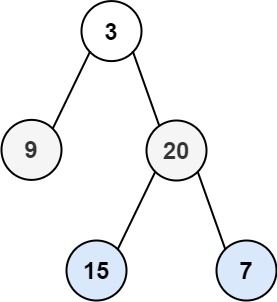Welcome to Subscribe On Youtube
102. Binary Tree Level Order Traversal
Description
Given the root of a binary tree, return the level order traversal of its nodes' values. (i.e., from left to right, level by level).
Example 1:

Input: root = [3,9,20,null,null,15,7] Output: [[3],[9,20],[15,7]]
Example 2:
Input: root = [1] Output: [[1]]
Example 3:
Input: root = [] Output: []
Constraints:
- The number of nodes in the tree is in the range
[0, 2000]. -1000 <= Node.val <= 1000
Solutions
Solution 1: BFS
We can use the BFS method to solve this problem. First, enqueue the root node, then continuously perform the following operations until the queue is empty:
- Traverse all nodes in the current queue, store their values in a temporary array $t$, and then enqueue their child nodes.
- Store the temporary array $t$ in the answer array.
Finally, return the answer array.
The time complexity is $O(n)$, and the space complexity is $O(n)$. Here, $n$ is the number of nodes in the binary tree.
-
/** * Definition for a binary tree node. * public class TreeNode { * int val; * TreeNode left; * TreeNode right; * TreeNode() {} * TreeNode(int val) { this.val = val; } * TreeNode(int val, TreeNode left, TreeNode right) { * this.val = val; * this.left = left; * this.right = right; * } * } */ class Solution { public List<List<Integer>> levelOrder(TreeNode root) { List<List<Integer>> ans = new ArrayList<>(); if (root == null) { return ans; } Deque<TreeNode> q = new ArrayDeque<>(); q.offer(root); while (!q.isEmpty()) { List<Integer> t = new ArrayList<>(); for (int n = q.size(); n > 0; --n) { TreeNode node = q.poll(); t.add(node.val); if (node.left != null) { q.offer(node.left); } if (node.right != null) { q.offer(node.right); } } ans.add(t); } return ans; } } -
/** * Definition for a binary tree node. * struct TreeNode { * int val; * TreeNode *left; * TreeNode *right; * TreeNode() : val(0), left(nullptr), right(nullptr) {} * TreeNode(int x) : val(x), left(nullptr), right(nullptr) {} * TreeNode(int x, TreeNode *left, TreeNode *right) : val(x), left(left), right(right) {} * }; */ class Solution { public: vector<vector<int>> levelOrder(TreeNode* root) { vector<vector<int>> ans; if (!root) return ans; queue<TreeNode*> q{ {root} }; while (!q.empty()) { vector<int> t; for (int n = q.size(); n; --n) { auto node = q.front(); q.pop(); t.push_back(node->val); if (node->left) q.push(node->left); if (node->right) q.push(node->right); } ans.push_back(t); } return ans; } }; -
# Definition for a binary tree node. # class TreeNode: # def __init__(self, val=0, left=None, right=None): # self.val = val # self.left = left # self.right = right class Solution: def levelOrder(self, root: Optional[TreeNode]) -> List[List[int]]: ans = [] if root is None: return ans q = deque([root]) while q: t = [] for _ in range(len(q)): node = q.popleft() t.append(node.val) if node.left: q.append(node.left) if node.right: q.append(node.right) ans.append(t) return ans -
/** * Definition for a binary tree node. * type TreeNode struct { * Val int * Left *TreeNode * Right *TreeNode * } */ func levelOrder(root *TreeNode) (ans [][]int) { if root == nil { return } q := []*TreeNode{root} for len(q) > 0 { t := []int{} for n := len(q); n > 0; n-- { node := q[0] q = q[1:] t = append(t, node.Val) if node.Left != nil { q = append(q, node.Left) } if node.Right != nil { q = append(q, node.Right) } } ans = append(ans, t) } return } -
/** * Definition for a binary tree node. * class TreeNode { * val: number * left: TreeNode | null * right: TreeNode | null * constructor(val?: number, left?: TreeNode | null, right?: TreeNode | null) { * this.val = (val===undefined ? 0 : val) * this.left = (left===undefined ? null : left) * this.right = (right===undefined ? null : right) * } * } */ function levelOrder(root: TreeNode | null): number[][] { const res = []; if (root == null) { return res; } const queue = [root]; while (queue.length != 0) { const n = queue.length; res.push( new Array(n).fill(null).map(() => { const { val, left, right } = queue.shift(); left && queue.push(left); right && queue.push(right); return val; }), ); } return res; } -
/** * Definition for a binary tree node. * function TreeNode(val, left, right) { * this.val = (val===undefined ? 0 : val) * this.left = (left===undefined ? null : left) * this.right = (right===undefined ? null : right) * } */ /** * @param {TreeNode} root * @return {number[][]} */ var levelOrder = function (root) { let ans = []; if (!root) { return ans; } let q = [root]; while (q.length) { let t = []; for (let n = q.length; n; --n) { const { val, left, right } = q.shift(); t.push(val); left && q.push(left); right && q.push(right); } ans.push(t); } return ans; }; -
// Definition for a binary tree node. // #[derive(Debug, PartialEq, Eq)] // pub struct TreeNode { // pub val: i32, // pub left: Option<Rc<RefCell<TreeNode>>>, // pub right: Option<Rc<RefCell<TreeNode>>>, // } // // impl TreeNode { // #[inline] // pub fn new(val: i32) -> Self { // TreeNode { // val, // left: None, // right: None // } // } // } use std::rc::Rc; use std::cell::RefCell; use std::collections::VecDeque; impl Solution { pub fn level_order(root: Option<Rc<RefCell<TreeNode>>>) -> Vec<Vec<i32>> { let mut res = vec![]; if root.is_none() { return res; } let mut queue: VecDeque<Option<Rc<RefCell<TreeNode>>>> = vec![root].into_iter().collect(); while !queue.is_empty() { let n = queue.len(); res.push( (0..n) .into_iter() .map(|_| { let mut node = queue.pop_front().unwrap(); let mut node = node.as_mut().unwrap().borrow_mut(); if node.left.is_some() { queue.push_back(node.left.take()); } if node.right.is_some() { queue.push_back(node.right.take()); } node.val }) .collect() ); } res } }